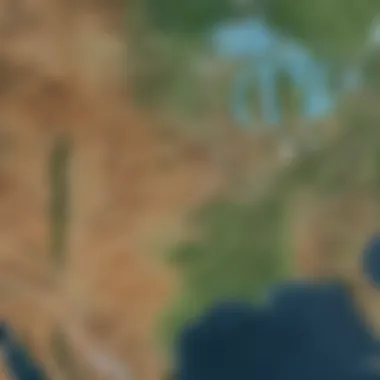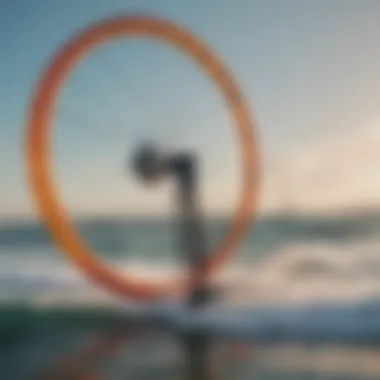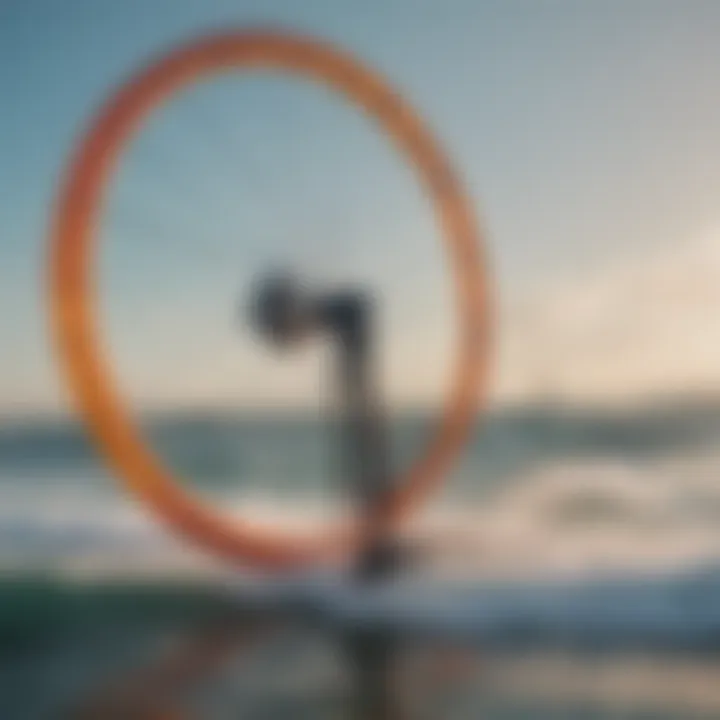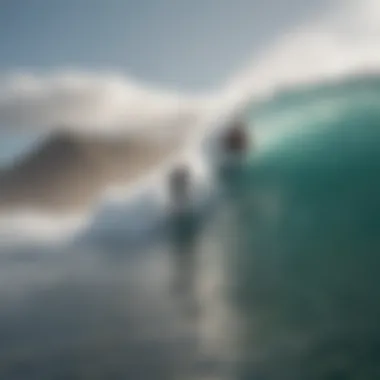Understanding the US Wind Forecast Map for Watersports


Intro
Understanding the forces of nature, especially when it comes to wind, is crucial for anyone who enjoys watersports. Whether you're surfing on the crest of a wave or sailing towards the horizon, wind patterns play a pivotal role in determining both the adventure and safety of your activities. This guide aims to demystify the US wind forecast map, offering watersports enthusiasts a solid grasp of how wind affects various water activities. From beginner techniques to advanced skills, we’re here to help you navigate the breezy waters.
Techniques and Skills
This section dives into the heart of mastering wind usage in your watersports endeavors. Knowing how to read the wind can mean the difference between a spectacular day on the water and a disappointing one.
Fundamental Techniques for Beginners
For those just starting, it’s essential to get a handle on some basics. Here are a few foundational techniques:
- Observe the Wind: Before you hit the waters, take a moment to stand still and feel the wind. Notice its direction and speed. This can provide a preliminary understanding of the conditions ahead.
- Use Wind Forecast Apps: Familiarize yourself with tools like Windy and PredictWind. These apps provide real-time data that can help inform your decisions on when and where to go.
- Practice with Smaller Flags: Simple tools like small flags or windsocks can be invaluable. Set them up where you plan to practice, and watch how they react to different wind strengths and directions.
Advanced Skills for Experienced Athletes
Once you’ve built a good foundation, here’s how to sharpen those skills further:
- Understand Wind Layers: The behavior of wind can vary at different altitudes. Knowing this concept can help you adapt your techniques according to what’s happening further up.
- Tweak Your Stance: Advanced athletes should experiment with their stance based on wind conditions. Sometimes, a slight adjustment in how you position your body can enhance performance dramatically.
- Communicate with Other Watersporters: Join local clubs or discussion forums to exchange tips about local wind patterns and forecasts. Being part of a community can yield insights that the maps alone often miss.
Safety and Gear
With great adventure comes the responsibility of ensuring your safety. By focusing on the right gear and adhering to safety protocols, enthusiasts can safeguard themselves while enjoying the thrill of their chosen activities.
Essential Safety Measures in Watersports
Before heading out, consider these vital safety measures:
- Life Jackets: Always wear a life vest when participating in any watersport, regardless of your experience level.
- Know Your Limits: Each sport has its own difficulty scale. Make sure to match your skills against the conditions to prevent accidents.
- Check Weather Updates Regularly: Use reliable sources to ensure that forecasts are updated in real-time, particularly for sudden weather changes.
Gear Reviews and Recommendations
Choosing the right gear can enhance both your performance and safety. Here are some noteworthy recommendations:
- Wetsuits: A good wetsuit not only keeps you warm but also provides some degree of buoyancy. Neoprene suits are highly recommended for colder waters.
- Surfboards: For surfing enthusiasts, a shorter board is often easier to maneuver in strong winds, while longer boards offer stability in calmer conditions.
- Sailboats: If sailing is your passion, consider brands like Hobie or Sunfish—they have proven track records for versatility depending on wind conditions.
Understanding wind patterns is not just about reading a map; it’s about embracing the changes and responding adaptively. With this knowledge, watersport enthusiasts can confidently chart their course.
Navigating the complexities of wind dynamics can be quite the task, but with the right techniques and safety measures in hand, watersports can transform into exhilarating experiences. The journey of becoming proficient in utilizing the wind awaits—dive in and enjoy!
Foreword to Wind Forecasting
In the world of watersports, understanding wind patterns and forecasts isn't just an added bonus; it's utterly essential. Whether you're sailing through the open seas, riding waves in a surf competition, or simply paddling on a calm lake, knowing how wind can shift can significantly influence your experience. Wind is like a silent partner in these activities—it affects speed, stability, and even safety. This section aims to shed light on the significance of wind forecasting and how it can be a game-changer for enthusiasts venturing into aquatic interests.
Significance of Wind in Watersports
Wind, often taken for granted by many, plays a crucial role in various watersports. For sailors, it’s the very force that drives their boats forward. For surfers, understanding wind direction can mean the difference between catching a perfect wave and a lackluster ride. Wind influences the currents and ripples across the water, creating ideal conditions for some activities while rendering others risky or less enjoyable.
In addition:
- Sailor’s ability to harness wind can determine their speed and route.
- Surfing relies heavily on wind direction; onshore winds can flatten waves, while offshore winds help them break perfectly.
- Kayakers need to adjust their strokes and navigation based on wind speed to maintain control.
So, for those who consider themselves watersport enthusiasts, reading the wind forecast is not just helpful; it’s a necessity that ties directly into their enjoyment and safety on the water.
Overview of Wind Forecasting Techniques
To navigate the waters effectively, understanding the techniques behind wind forecasting is paramount. These forecasts are derived from various sources and technologies, combining meteorological data with real-time monitoring. Here’s a rundown of some common wind forecasting methods:
- Numerical Weather Prediction (NWP): This method involves using mathematical models of the atmosphere to predict wind patterns. It’s a complex process, but it’s one that forms the backbone of modern forecasting.
- Satellite Observations: Satellites capture vast amounts of data from above, allowing meteorologists to analyze weather systems and gather information on wind speed and direction from multiple locations simultaneously.
- Ground Stations: Local weather stations measure wind speed and direction, recording data that can help refine forecasts for specific areas.
- Buoy and Marine Data: On rivers, lakes, and oceans, buoys equipped with sensors track wind conditions alongside other environmental factors, proving quite useful for real-time updates.
- Weather Apps and Online Resources: Many enthusiasts today access forecasts through apps that provide localized wind data. It’s fast, convenient, and often includes additional features like live wind maps.
It’s important to remember that wind forecasts can change rapidly; trusting multiple sources helps paint a clearer picture of what conditions might be like.
Understanding these techniques empowers watersport enthusiasts to take informed decisions regarding their adventures. With knowledge about how wind forecasts are constructed, one can appreciate not just the numbers on a map but the implications these forecasts carry for playing out on the water.
Components of the US Wind Forecast Map
Understanding the components of the US wind forecast map is essential for watersports enthusiasts. This map is more than just a pretty color display; it’s a vital tool that can make or break a day out on the water. Being able to accurately interpret what you see is crucial, as wind conditions can often be the difference between a thrilling water sports session and a dangerous one. Let’s delve into the specific elements that make up this forecast and discuss how each of them influences various activities.


Mapping Wind Speed
When outdoor enthusiasts look at the wind forecast map, one of the first things that jumps out at them is the wind speed depicted across different regions. This measurement is typically shown using an array of colors or numerical values, and understanding these is crucial for decision making.
Wind speed can directly affect how much fun one can have while participating in watersports; for instance, sailing requires a minimum wind speed to truly get moving, whereas kiteboarding needs a different range altogether.
- Light Winds (0-10 mph)
- Moderate Winds (11-20 mph)
- High Winds (20+ mph)
- Ideal for casual sailing or paddleboarding, offering a serene experience without much risk.
- Best for those looking to harness more energy for activities like windsurfing; this speed range tends to be where most water sports enthusiasts thrive.
- Can be exhilarating but also dangerous. Conditions become challenging and sometimes unpredictable, pushing inexperienced individuals to reconsider their plans.
Keeping an eye on these wind speed indicators allows athletes to gauge the suitability of conditions ahead of time and adjust their gear or plans accordingly.
Visualizing Wind Direction
Wind direction is another crucial aspect that can’t be overlooked. The wind does not merely flow uniformly; it comes from specific points, which can dramatically influence your watersport experience. Most maps present wind direction with arrows or lines indicating the source of the wind, often associated with degrees on a compass.
Here are some points to consider:
- From the North (0°): This can lead to cooler waters and breezy conditions, possibly impacting the temperature for activities like surfing.
- From the South (180°): Warm winds can create pleasant conditions but may also signal stiffer breezes that require more skill.
- Shifts in Direction: Sudden changes in wind direction, often represented by movement in those arrows, can signal coming weather changes. Understanding this not only helps in navigating your activities but also in ensuring your safety.
Understanding Wind Gusts
Wind gusts can be tricky and are often the wildcard in your wind forecast. These sudden, brief increases in wind speed can create unexpected challenges that no one wants to face while out on the water. Gusts are shown on the forecast map and often represent quick changes that can happen throughout the day.
- Impacts on Watersports:
- Gusts can provide extra lift for windsurfers but can also lead to loss of control if not anticipated.
- For kayakers, sudden wind gusts can create large waves, potentially leading to capsizing if one isn't cautious.
"Understanding how to read gusts on a wind forecast map can sometimes make the difference between a fun day or a challenging one."
In short, familiarizing oneself with the components of the US wind forecast map equips watersports enthusiasts with the knowledge they need to navigate their adventures safely and effectively. Prior research into mapping wind speed, direction, and gusts helps not only in choosing the right day for activity but also in preventing dangerous situations that can arise from unpredicted wind conditions.
Interpreting the Wind Forecast Map
Interpreting the wind forecast map is crucial for watersports enthusiasts who want to maximize their experience on the water. Understanding how to read this map not only aids in choosing the right time to engage in their favorite activities but also plays a critical role in ensuring safety. The nuances of wind conditions can significantly affect performance and enjoyment, making this knowledge foundational for anyone looking to navigate wind-related challenges.
Navigating Symbols and Colors
When first glancing at a wind forecast map, it can seem like a jumble of colors and symbols, almost like a treasure map that requires deciphering. Each color typically represents different wind speeds, while unique symbols may denote gusts or changes in direction. For instance, darker shades of blue might indicate calmer winds, while bright reds and oranges signal stronger gusts.
- Color Scheme: Familiarize yourself with the color gradient on the map.
- Symbols: Look for arrows that represent wind direction. The length of the arrow often shows wind intensity; longer arrows typically indicate stronger winds.
- Light greens generally mean light winds (around 5-10 knots).
- Yellows could indicate moderate wind speeds (10-20 knots).
- Reds suggest more turbulent conditions (20+ knots).
Remember, each forecasting service might use slightly different symbols, so it’s wise to consult their legend or guides. A good tip is to have a reliable app on your phone that offers detailed explanations of these elements. Thus, athletes can tailor their gear and strategies to suit the day's conditions.
"Understanding what each symbol and color means allows you to be a better navigator on the water."
Temporal Trends in Wind Patterns
Diving deep into the temporal trends, understanding when wind patterns shift adds another layer to your planning. Wind conditions can vary significantly not just daily but also seasonally. For instance, summer might bring lighter, more consistent winds ideal for kayaking, while winter could raise more unpredictable gusts perfect for windsurfing.
It’s essential to consider:
- Time of Day: Winds often pick up in the afternoon due to temperature differences between land and water. This can create ideal conditions for sailing.
- Day-to-Day Variability: Consistent checking of daily forecasts gives a clearer picture. A windy day today may lead to calm conditions tomorrow.
- Seasonal Wind Trends: Familiarity with typical wind patterns during different seasons can help athletes prepare, whether it’s knowing when to expect folks on the surfboard or when to store the sailing gear.
Impact of Wind Forecasts on Specific Watersports
Wind forecasts play a crucial role in the enjoyment and safety of various watersports. As any seasoned enthusiast will tell you, being in tune with wind conditions can make or break an outing on the water. Different activities demand different wind strengths and directions, meaning that understanding these forecasts can lead to better decisions on when and where to participate in your favorite sport. This section delves into specific watersports and illustrates how the wind forecasts can influence performance and safety.
Sailing: Harnessing the Wind
For sailors, the wind is not just a factor; it's a vital ally. Sailboats rely on wind speed and direction to navigate efficiently. A good wind forecast can dictate whether a long-awaited voyage becomes a graceful glide through the waves or a frustrating struggle against headwinds. Experienced sailors know to analyze the forecast to find optimal conditions for either racing or leisure sailing.


- Key Considerations:
- Wind Patterns: Understanding prevailing winds can help in choosing the best route.
- Gusts and Shifts: Acquaintance with sudden gusts and wind shifts is essential for avoiding capsizing.
- Tidal Influence: The interplay between wind and tides requires sailors to stay updated, ensuring they're equipped to handle unexpected changes.
Surfing: Timing the Swell
Surfing is all about timing, and wind conditions greatly impact the quality of the waves. Forecast maps help surfers predict when swells are likely to be optimal. Wind can create challenging conditions or build up exciting waves, depending on where it's blowing from.
- Considerations to Keep in Mind:
- Onshore vs. Offshore Winds: Onshore winds can create choppy surf while offshore winds generally clean it up, leading to better rides.
- Forecast Timing: Knowing when wind conditions will change can drastically influence surf sessions.
Kayaking: Wind Considerations
For kayakers, wind can either be a boon or a bane. While a little breeze can enhance paddling conditions, strong winds can make for an arduous journey or, worse, a hazardous one.
- Things to Remember:
- Wind Speed: Keeping an eye on the wind speed is key to planning an enjoyable outing.
- Wind Direction: Paddling into the wind can tiring; knowing how to gauge wind direction aids in planning return routes.
Windsurfing: The Dance with the Elements
Windsurfing combines the thrill of both sailing and surfing, making wind conditions pivotal to an enjoyable experience. Wind forecast maps are indispensable for windsurfers aiming to catch the perfect breeze.
- Important Elements:
- Ideal Wind Speeds: Different levels of experience correlate with different preferred wind speeds; beginners may seek lighter winds, while experts thrive on stronger gusts.
- Spot Selection: Choosing the right location often hinges on both wind direction and local geography, making forecasts essential to identify the perfect spot to windsurf.
A well-constructed wind forecast can mean the difference between harmonious water sports experience and frustrating misadventures on the water.
Technological Advances in Wind Forecasting
Advancements in technology have fundamentally changed the landscape of wind forecasting, offering more precise and timely data for watersports enthusiasts. Knowledge of these technologies not only enhances the overall experience but is also crucial for player safety. With better forecasting, athletes can make informed choices about when to hit the water, thus elevating their performance.
Satellite Imaging and Data Analysis
Satellites have become the eyes in the sky, capturing expansive data that influences the understanding of wind conditions. The role of satellite imaging in forecasting cannot be overstated. Equipped with high-resolution instruments, satellites monitor a wide array of meteorological parameters. These include wind patterns, temperatures, and even the interactions between the ocean and atmosphere.
- Global Coverage: Satellites provide uninterrupted monitoring across vast areas, unlike localized ground stations. This enables an understanding of larger trends that can affect smaller regions.
- Data Analysis: The data collected undergoes rigorous analysis. Advanced algorithms process this information, giving forecast models a crucial edge in predicting wind shifts that may not be immediately observable.
- Model Integration: Satellite data can be integrated with other forecasting models, refining the accuracy of predictions. This collaboration creates a more holistic understanding of weather dynamics.
Furthermore, satellites aid in detecting severe weather events, allowing watersports enthusiasts to avoid unsafe conditions. However, these technologies are not foolproof; they come with inherent limitations, such as data latency and the occasional miscalibration of sensors. Understanding these caveats can help users interpret the forecasts with a critical eye.
Real-Time Wind Monitoring Systems
Real-time wind monitoring has revolutionized how athletes prepare for and respond to changing conditions. These systems utilize an array of technologies, from anemometers to mobile apps, providing instant updates on wind speed and direction.
- Local Sensors: Networked sensors placed at various spots along the coastline feed live data into centralized systems. This localized approach is particularly beneficial when forecast models don't account for microclimates.
- User-Friendly Apps: Many avid watersports lovers have turned to apps that compile this data into easy-to-understand formats. Simple graphical representations and alerts can quickly inform when conditions are ideal or when danger is imminent.
- Alert Systems: Integration with safety protocols sets real-time systems apart. Alerts can notify users about sudden gusts or persistent high winds, which can be lifesaving in outdoor activities.
Despite the advances, relying solely on real-time data poses risks. Conditions can shift unexpectedly, and systems might not capture every gust. Thus, it's essential to supplement real-time data with a broader understanding of general weather patterns.
"Technology is transforming the landscape of wind forecasting, making it safer and more efficient for water sports enthusiasts to enjoy their passions."
Safety Measures: Navigating Wind Conditions
Wind conditions can transform a delightful day on the water into a precarious endeavor in the blink of an eye. Understanding and implementing safety measures is not just about caution; it’s about ensuring a pleasurable and safe experience for water sports enthusiasts. Winds can whip up waves that are benign in the morning but turn into challenging swells by the afternoon. The right safety strategies can make all the difference in enjoying your favorite water activity while minimizing risks.
Understanding Wind Alerts
Wind alerts serve as the first line of defense for anyone planning to venture onto the water. They inform enthusiasts of impending changes in conditions that might affect safety. Familiarity with local alert systems—sometimes issued by government agencies or local weather stations—can offer a significant advantage. It’s important to know how alerts are communicated. They may come as:
- Advisories: Indicating heightened caution without specified threats.
- Watches: Signaling conditions that could become hazardous.
- Warnings: These are the most serious, indicating immediate action is needed.
To get the best out of wind alerts, follow these practices:
- Regularly Check the Forecast: Make it a habit to look at updates a day before heading out.
- Stay Connected: Use weather apps on your phone for real-time updates.
- Share Information: When out with others, keep each other informed of any alerts you receive.
"Wind alerts are your safety parachute; respect them, and they’ll respect you back."


Preparing for Sudden Wind Changes
The only constant in the world of wind is change. Suddenly, what felt like a gentle breeze can escalate into a full-blown gale. Preparing for these shifts is crucial in handling the unpredictable nature of winds. Here are some steps to take:
- Stay Informed: Use advanced weather applications that offer alerts specific to your location. Some apps provide hyper-local data that are more accurate for the exact area you plan to navigate.
- Choose the Right Gear: Select equipment designed to perform well under varying wind conditions. For instance, using a surfboard that's adaptable can offer you the edge when winds go from mild to strong.
- Know Your Limits: Everyone has their comfort zone. Be realistic about your experience level, and don’t push your boundaries in unfavorable conditions.
Furthermore, understanding how to read wind patterns visually can also help. Observing the water and recognizing slight color or surface variations can provide clues about wind strength and direction changes.
Adapting your plans based on both current conditions and forecasted alerts is essential. After all, the ultimate aim is to enjoy those exhilarating watersports without putting yourself in jeopardy.
Environmental Factors Influencing Wind Patterns
Understanding how different environmental elements affect wind patterns is crucial for watersports enthusiasts. Wind doesn't blow in isolation; it interacts with various physical features and weather conditions. Analyzing these factors can offer deeper insights into making safer and more informed decisions when engaging in water activities. Here’s a closer look at how topography and seasonal variations play into the complexities of wind dynamics.
Topography and Its Effects
Topography significantly influences wind flow and patterns. Hills, mountains, valleys, and bodies of water can redirect, accelerate, or even weaken winds. For instance, when wind travels over a mountain range, it often experiences a phenomenon called orographic lift—where it rises and cools, leading to cloud formation and precipitations in certain zones. Conversely, this can create shadow effects on the leeward side, where winds tend to be weaker and drier.
Understanding the layout of a location is essential for watersports. Here are a few key points to consider:
- Wind Acceleration: Wind speeds tend to increase in narrow valleys, making it essential for sailing and other wind-driven sports.
- Obstructions: Buildings or natural barriers can disrupt wind direction and intensity. It might be wise to scout areas without too many obstructions if you’re planning to participate in kitesurfing or windsurfing.
- Local Microclimates: Some areas create unique weather patterns due to their topographical features. Recognizing these microclimates can provide an edge, particularly when timing your activities with favorable conditions.
"Topography is not merely a background; it's a player in the wind game."
Seasonal Variations
Wind patterns can vary dramatically across different seasons, influenced by a combination of temperature changes, geographical differences, and atmospheric pressure systems. Seasonal shifts can dictate how and when to engage in your favorite watersports.
- Spring and Fall: Transition seasons often bring about dynamic wind conditions. Spring storms may lead to unpredictable wind gusts, which can be both a thrill and a risk for sailing and surfing
- Summer: During warmer months, coastal areas frequently experience sea breezes, where cooler air from over the water moves in to replace rising warm air. This can create consistent winds, ideal for sailing and kitesurfing.
- Winter: Cold fronts can lead to strong winds in many regions. Watersports enthusiasts must be cautious, as strong gusts may transform casual outings into challenging conditions.
As you can see, awareness of seasonal variations empowers you to align your watersport plans with optimal wind conditions. Keeping an eye on local forecasts and understanding these seasonal trends is pivotal for safety and enjoyment.
Being armed with knowledge about environmental factors can make all the difference in your experience out on the water, ensuring that you maximize performance while navigating nature’s whims.
Future of Wind Forecasting in Watersports
The wind plays a pivotal role in shaping the experiences of watersports enthusiasts, influencing everything from the intensity of the sails to the swells of the ocean. As technology progresses, the methods for forecasting wind patterns are evolving, offering improved accuracy and a deeper understanding of wind behavior. The future of wind forecasting holds significant implications for anyone involved in watersports.
Emerging Trends in Forecasting Technologies
Today, we can expect advancements in forecasting technologies to revolutionize how athletes approach their activities. For instance, the use of drones equipped with sensors allows for real-time data collection on wind conditions. These drones can gather information from hard-to-reach areas, ensuring that forecasts reflect the current state of the environment more reliably than ever before.
Moreover, machine learning is making waves in predictive modeling. Algorithms can analyze vast amounts of historical and current data to spot patterns that human forecasters might overlook. This results in more nuanced predictions of wind behavior, which is crucial for watersports ranging from kayaking to windsurfing. The enhanced granularity provided by these technologies means athletes can tailor their approaches more precisely.
However, while these innovations are exciting, they come with their own set of challenges. Increased data means increased complexity, and understanding how to interpret this information effectively becomes essential. Relying solely on technology without a fundamental grasp of the basics of wind patterns can leave watersports enthusiasts vulnerable to unexpected conditions.
Integration of Predictive Analytics
As we look forward, the integration of predictive analytics into wind forecasting promises to change the game for watersports. This approach harnesses data not just from meteorological databases but from a broader ecosystem. Social media posts and user-generated content on platforms like Reddit and Facebook can inform trends in local weather conditions and crowd-sourced reports on wind and swell patterns.
All this data can be analyzed to deliver not just forecasts but insights. For example, predictive models can suggest optimal times and locations for activities based on historical patterns, current weather, and other factors like tide cycles. This means that a surfer can get information on the best times to catch a wave, while sailors can optimize their routes to harness favorable winds.
"The wind doesn't just blow where it wants; it dances with the water and the land, and we must learn its steps to dance along."
Using predictive analytics within a wind forecast map provides actionable recommendations. Enthusiasts can make informed choices based on nuanced data rather than guesswork, improving both safety and performance. The future of wind forecasting thus holds the promise of a more tailored approach to enjoying watersports, where individuals can maximize their experiences with a clear understanding of natural dynamics.
Epilogue: The Integral Role of Wind Forecasts
Understanding the wind forecast and its implications for watersports enthusiasts is not just a matter of convenience but a crucial element for ensuring safety, performance, and enjoyment on the water. The wind plays a fundamental role in a range of watersports, from sailing to surfing, making the ability to interpret forecasts an invaluable skill.
Summary of Key Insights
The review of the US wind forecast map reveals several key insights:
- Impact on Activities: Different watersports react uniquely to varying wind conditions. For example, sailors thrive on steady winds, whereas surfers need a mix of wind and swell to achieve the perfect ride.
- Real-Time Decisions: Access to real-time data allows enthusiasts to adapt their plans based on the day’s specific wind patterns. The maps offer vital clues that influence decisions about departure times, routes, and safety measures.
- Technological Assistance: The innovations in wind forecasting tools enhance our understanding of wind dynamics. Tools like satellite imagery and real-time monitoring systems have substantially improved the accuracy of predictions that watersports participants depend upon.
- Element of Safety: Knowing how to interpret wind forecasts helps in recognizing potentially hazardous conditions. Sudden gusts or shifts in wind direction can lead to dangerous situations. Awareness of these elements leads to informed choices that can avert mishaps.
Encouragement for Continued Exploration
As we navigate the complexities of wind forecasting, it’s essential to remain curious and proactive in exploring newer methods and technologies. Watersports enthusiasts should not only familiarize themselves with basic forecasting but also engage with communities and resources that provide ongoing education.
Engaging with platforms like Reddit can be beneficial, as many enthusiasts share personal experiences and tips that can enhance understanding.
Moreover, experimenting with various forecasting tools, apps, or websites leads to a deeper appreciation for forecasting nuances. Checking updates regularly on reliable sources like Wikipedia and Britannica can also keep one informed about the latest developments in wind patterns.
By developing a skillful grasp of wind dynamics and embracing various educational resources, watersports enthusiasts can elevate their experience and create safer, more effective adventure outings. In the ever-evolving world of wind forecasting, continuous learning is the wind at our backs.















